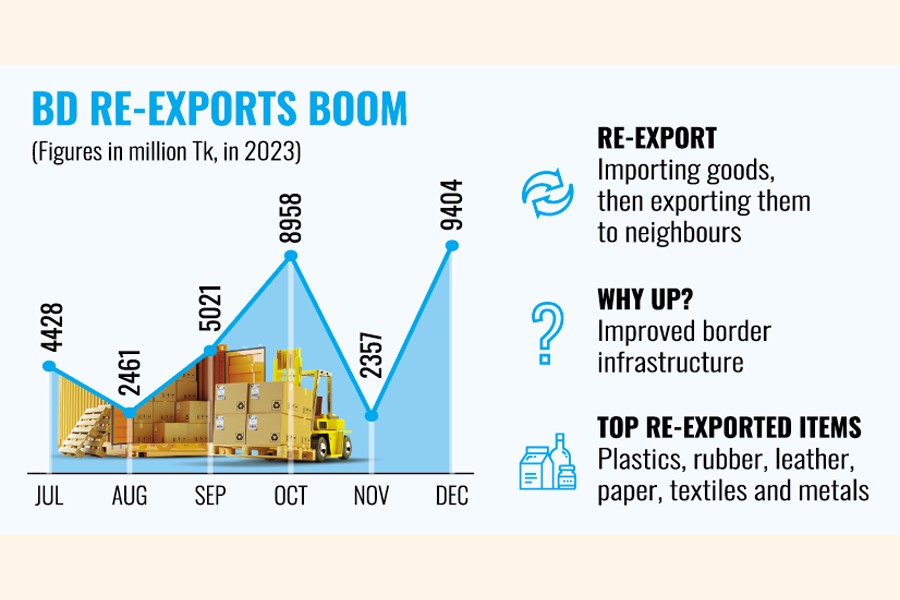
BD sees rise in re-exports on border infra upgrade
The trade growth also aids landlocked neighbours
JASIM UDDIN HAROON | Saturday, 30 March 2024

The value of re-exported goods from Bangladesh has been increasing gradually, coinciding with developments in border infrastructure, including roads and land customs stations.
Data from the Bangladesh Bureau of Statistics (BBS) shows that the re-export value stood at Tk 9,404 million in December 2023.
Previous months saw lower figures: Tk 2,357 million in November, Tk 8,958 million in October, Tk 5,021 million in September, Tk 2,461 million in August and Tk 4,428 million in July.
Re-export refers to goods imported into Bangladesh and subsequently sent on to neighbouring economies, such as the landlocked countries of Bhutan and Nepal. This process adds minimal value from Bangladesh's perspective.
Neighbouring economies, primarily Bhutan and Nepal, use Bangladeshi ports to procure goods, mainly industrial raw materials. Bangladesh earns a small handling fee for these transactions.
People familiar with the development told The Financial Express that the recent expansion of re-export activity is due mainly to developments in road and land customs station infrastructure.
Economists believe there is potential for even higher re-export volumes, citing popular tourist destination Nepal's large population and Bangladesh's existing Preferential Trade Agreement (PTA) with landlocked Bhutan.
"This [re-export volume] is now roughly $10 million... It should go higher as Nepal has a huge population," Dr Ahsan H Mansur, executive director of the Policy Research Institute of Bangladesh, told the FE.
Nepal's population is estimated at around 30.9 million, while Bhutan's is around 0.8 million.
Ahsan H Mansur said the UN mandates providing such trade facilities to landlocked countries.
He suggested further improvements in connectivity to attract more re-exports, enabling Bangladesh to earn multiple charges from such trade.
He describes this activity as a type of transhipment, essentially adding value through transhipment.
Meanwhile, Dr Masrur Reaz, CEO and chair of Policy Exchange Bangladesh, identified north-east India as a potential destination for re-exports. However, non-tariff barriers (NTBs) imposed by India have limited trade volumes.
In contrast, he said the economies of Nepal and Bhutan have expanded in the post-pandemic era, with a focus on importing industrial raw materials.
Bangladesh signed its first preferential trade agreement with Bhutan in 2020. This agreement allows duty-free access for both countries.
The main goods re-exported from Bangladesh include plastics, rubber, leather and animal gut, paper and paperboard, paper pulps, printed books, man-made filaments, man-made staple fibres, wadding felts and non-wovens, special yarn, impregnated and coated textile fabrics, clothing accessories, stone, cement, glass and glassware, iron or steel, copper and aluminium.